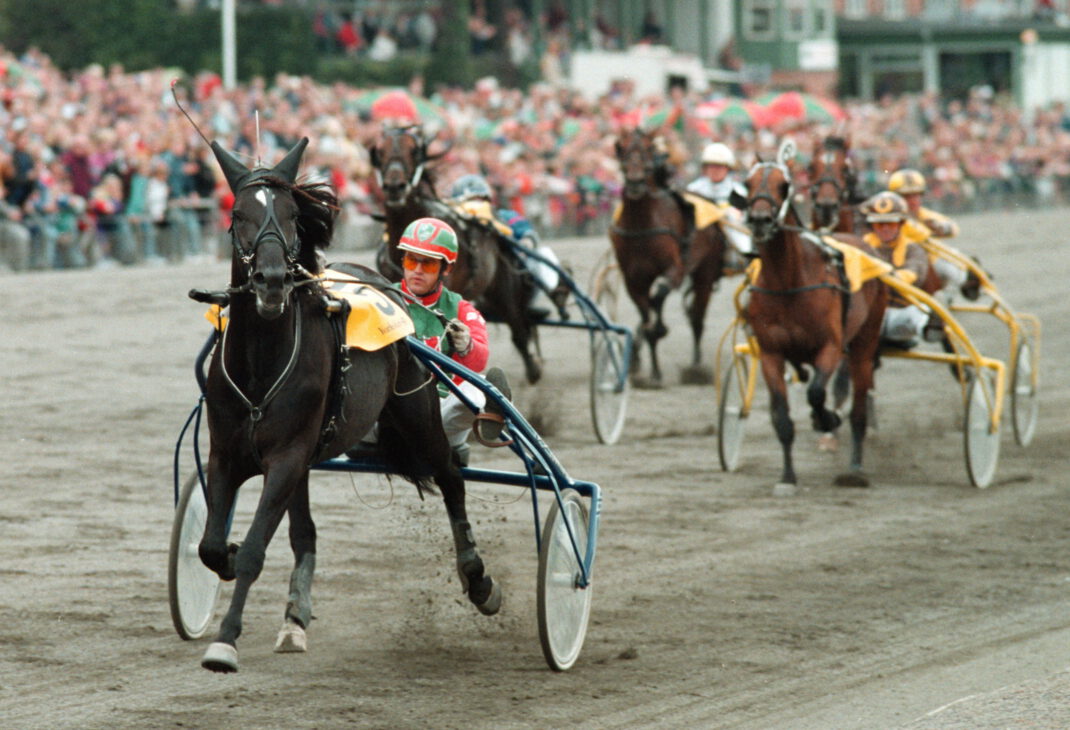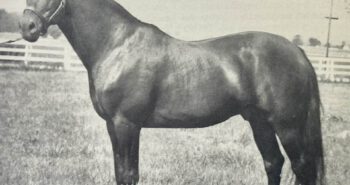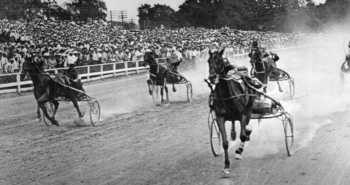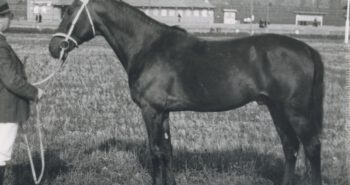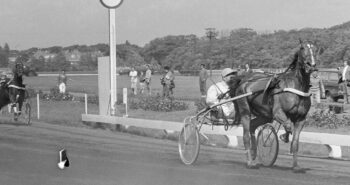He was seemingly on his way to massive international stardom, but lady luck didn’t shine her light on Rudolf Le Ann. His owner died in a plane crash on the way to watch his beautiful black colt race, and two years later, as the colt appeared to be “better than ever,” he was struck with a life-threatening illness which set him back permanently.
When Rudolf Le Ann started racing in 1993, it was evident that Danish trotting finally had a possible worthy successor to Tarok, their legendary superstar trotter of the 70s. Initially, though, it wasn’t that clear-cut. Tarok’s trainer Jørn Laursen broke Rudolf to harness but felt that that the yearling was maybe too wild to become a good racehorse.
Arne Normann was hired by breeder-owner Danny Bendtsen in December 1989 and deserves most of the credit for improving the manners of the black son of Peter Haughton-winner Why Not. “He was a challenge early on, because he was scared of everything. He was scared of anything new, scared of other horses, you name it. He would panic if the other horses came too close, for example. It was a struggle, but eventually he learnt to calm down. When he started racing, though, I think he outran the other horses just to get away from them,” smiles Normann.
The plane crash
It didn’t take too long for the rumor mill to start spinning, and as soon as he hit the tracks, he confirmed the rumors and more. When Rudolf was 3 it was obvious he was superior to his Danish competitors and needed to go abroad to be properly challenged. Rudolf’s first real test abroad was Färjestads Nordiska 3-åringspris, where he would cut his teeth on the outstanding Swedish three-year-old trio of Ina Scot, Top Love and Opus Broline, of which the former went on to be a world star.
Arne Normann transported the picturesque colt by car to Karlstad, in midwestern Sweden, while breeder-owner Denny Bendtsen hired a private plane to carry him, his partner Susanne, trainer-driver Steen Juul and a few others to Karlstad. “I drove up on Thursday, while the others were flying on race day. I remember Denny was afraid of flying, but Susanne didn’t want to drive that long distance, and they hired an extra pilot just to be on the safe side,” Normann recalls.
The raceday started normally. However, it would turn out to be anything but. Says Normann; “they didn’t arrive when expected and I just thought they were delayed, so I did the warm-up. But as the race was about to start and they still weren’t there, I was asked if I wanted to scratch Rudolf. I wanted to start, though, and got Olle Goop to drive him.”
Rudolf Le Ann put in a massive performance. Taking the lead, he broke stride for no reason but found his feet relatively quickly. The Danish trotter ended up parked outside the spectacular Ina Scot and fought like a lion down the final stretch but lost by half a length. Still, it proved the son of Why Not was something extra. Looking back at it 32 years later, Normann is still proud of how Rudolf Le Ann performed: “He raced great that day and didn’t lose by a lot to Ina Scot. To trot in 1.14,8 (2:00.2f) after being parked outside was a really great performance. But if we could have stuck to our usual routines, I think he could have won.”
But the colt’s heroic effort was soon forgotten when the cause of the delay became known: the chartered plane had run out of fuel and crashed in the large Lake Vänern just south of Karlstad. Steen Juul and two other passengers survived the relatively high waves in the cold water but five, the breeder-owner Denny Bendtsen and his wife, Anders Mysager, CEO of the Charlottenlund racetrack and pilot and his friend, died. Danish journalist Carsten Bundgaard later revealed he was also supposed to have been on the plane in order to broadcast the race to Denmark, but his employer, DR, cancelled the seat just a few days prior. He said this probably saved his life.
“A journalist came over and told me there had been a plane crash and that Rudolf’s owners were dead. That’s how I found out. I remember he also wanted to take a photograph of the horse then and I lost it with him – but what can you expect? The ground just fell out from underneath me, it was such a shock. Denny was the best employer I ever had, he was absolutely fantastic and there were never any issues,” recalls Normann.
European champion
Later in the season he triumphed in the Danish Criterium before tasting international glory as he won the European Championship for 3-year-olds after a strong performance, winning despite being parked outside of the Finnish trotter Boss Is Back most of the race. Even though the winning margin was slim there was no question that Rudolf, now owned by Bendtsen’s daughters Ann and Lea – also the origin of the breeders’ name “Le Ann” – was the strongest that day. European champion, yet the horse wasn’t at the top of his game. According to Normann; “I had to take him to the veterinary hospital at Bjerke, because he had thickened blood and wasn’t fully fit. Still, he won that race after being parked outside. It just shows how good he really was.”
An emotional Derby win
At 4, he continued his dominance. Rudolf first defeated the others top trotters in the Danish crop in the Jydsk Grand Prix and was a massive favorite in the Danish Derby. With the sad background story, the Danish trotting fans were all rooting for the Bendtsen sisters and the son of Why Not. Steen Juul let the others set a high initial tempo, then sent his superstar-in-the-making to the front after one lap. In the last turn Rudolf Le Ann just left his competitors in the dust and won easily in world record time 1.15,9 over 3000 meters (2:02.1f in 1 7/8 mile). “He had plenty left, he was really in peak form today. This horse has unlimited potential,” Juul said immediately after the four-year-old had won the big race.
Going abroad for the Grand Prix de l’UET, the European Derby, he won his elimination heat at Solvalla. But there wouldn’t be a “clash of the titans” meeting with Ina Scot, who then stood at 27 straight wins, in the final in Italy: in the victory lap it became apparent that Rudolf had picked up an injury. Instead of starting in the final and potentially winning a big European race, the black colt was out for several months.
A life-threatening illness
Back from injury he was, according to Juul, better than ever. At the end of April, he won Taroks Mindeløb and was set to debut against the European aged elite, including Copiad, Queen L, Abo Volo and Sea Cove, in the Oslo Grand Prix two weeks later.
“I am not sure people realize how good he was,” Juul later said. But unfortunately, it didn’t matter. Instead of taking on some of Europe’s top trotters, Rudolf instead found himself in a battle of life and death with gastric volvulus. The trotter survived his brush with death after an operation, but it killed the some of the magic. “In my eyes Rudolf Le Ann never returned to anywhere the same form as before. But until then, everything was an adventure, Juul said in an interview with Danish daily Ekstrabladet. Normann shares Juul’s thoughts: “Not a lot of horses recover and make it back on the track after that – yet Rudolf did. He didn’t have the same strength, though, but did really well later, too.”
Reunited with Arne
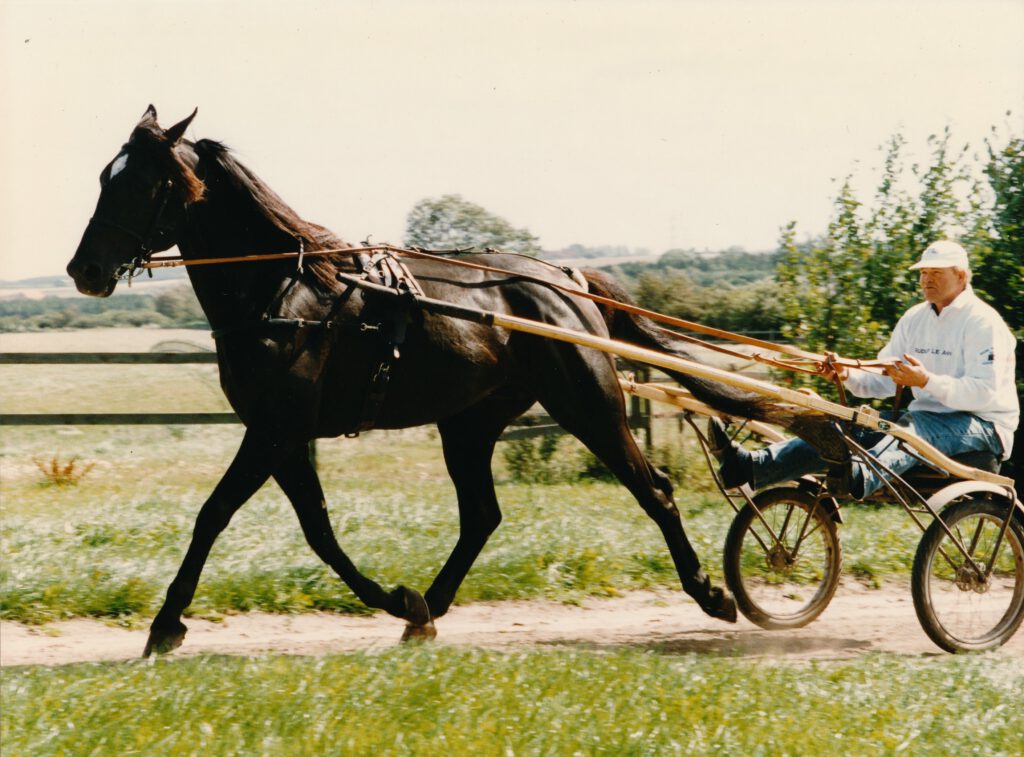
Photo: Burt Seeger/DTC’s Fotoarkiv, used with permission.
Arne Normann started up as a trainer and was away from the Rudolf Le Ann in a less successful period for the colt. In 1997, the owners chose to move the beautiful black colt to Normann. Both Rudolf and Normann were very happy to re reunited, and Normann was also crystal clear how important his four-legged best friend was to him. “Rudolf Le Ann has meant almost everything to me. Just being allowed to work with such a horse was something I wouldn’t have gone without. As a two-year-old he was a bit of an oddball who was a challenge, but fortunately he changed soon enough, and he has given me so many wonderful experiences over the years. He took a lot of room in the stable and had his own opinions about things. It all revolved around him, and he could get angry and sullen if he didn’t et the attention he thought he deserved. Then he would stand there biting the stall door and chewing on the bars in anger. I think we changed the door several times while we had Rudolf”, Normann said in an interview with the Danish site Travsportshistorie.
The move paid off immediately. Rudolf Le Ann blossomed, but that was probably also a result of completely different surroundings. Normann trained Rudolf Le Ann at the beaches in Northern Denmark, and the black colt just loved running with waves from the Atlantic Ocean around his hooves. “He just loves getting in the water. The salt water is really good for him and his hooves,” Normann commented. It was in fact so good for him that, even though he wasn’t at the same level, he bounced back and won the Danish Championship in 1998 – a race he had also won in 1993 and 1996. Rudolf also tasted international glory again by winning the Sweden Cup in two straight heats in 2000. In his interview with Travsportshistorie, Normann also told the story of how the colt responded in his own way to winning or losing: “There is no doubt whatsoever that Rudolf Le Ann had a great personality. He was the one who decided who he wanted to talk to – if there was someone he didn’t feel like talking to, his ears would lie flat on his neck, but he was always nice to me. He also knew perfectly well if things had gone well or badly in the races. If he had won, he would howl and make a fuss when we got home, but if he had lost, he would almost sneak into the stable. It was actually fun to watch.”
But examining his career with the benefit of hindsight, there is absolutely no question that, even though he was always a good horse, the life-saving operation for his gastric volvulus did something to Rudolf Le Ann. He could have been an absolutely star without it – and he had the pedigree to go along with it. His second dam, Larine Hanover, was in blood a full sister to Somolli, and his sire Why Not was a good sire in Scandinavia.
After a race in Århus on May 1, 2001, the 12-year-old Rudolf Le Ann put in a poor performance, though was still third, and after a veterinary check it was decided to retire him. At the same time, the owners chose to transfer the horse to Arne Normann for one Danish krone as a thank-you for his efforts over the years.
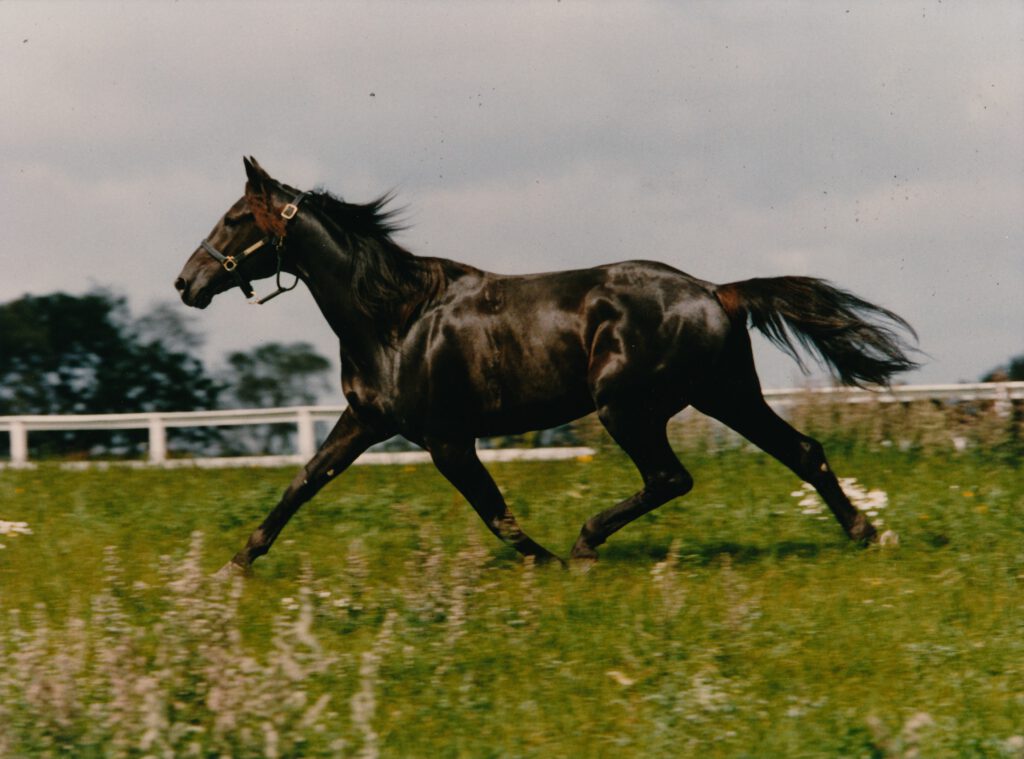
Rudolf Le Ann stood stud for several years but was never able to pass on his abilities as a stallion. He passed away in 2012, 23 years old. A few days later Juul honored Rudolf Le Ann in an article in Ekstrabladet: “It’s the best horse I ever trained. He was an amazing horse with an outstanding willpower which made him perform beyond his limits.”
The Danish black pearl was buried at Normann’s farm. “One day he couldn’t get up and I had to do what was right for him and called the local veterinarian. Now he’s buried in the field. It’s a big field and I have some other horses there. There’s beautiful green grass where he is buried, but the horses don’t walk on top of that spot, or eat that grass there, even to this day. It really makes you wonder. There are some things between heaven and earth we don’t understand, I guess.”
Despite his achivements both in Denmark and internationally, Rudolf Le Ann has still not been inducted into the Danish Trotting Hall of Fame.
rudolf le ann
Black colt born in Denmark on Mar 26, 1989. Died in Brovst, Denmark on Feb 27, 2012.
Why Not – Lucretia Hanover (Florida Pro)
109 starts: 44-11-11 – Fastest time: 1.12,2 (1:56.1f) – Fastest win: 1.12,7 (1:57f) – 5,457,108 DKK
Breeder: Lea & Ann Bendtsen
Owners: Danny Bendtsen – Stald Le Ann – Arne Normann
Trainers: Steen Juul and Arne Normann
Drivers: Steen Juul, Birger Jørgensen, Erik Adielsson, Seppo Kukkonen, Flemming Jensen, Preben Kjærsgaard, Thomas Bonde and Henrik Lønborg
Groom: Arne Normann

